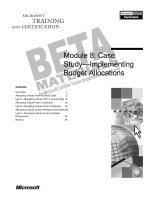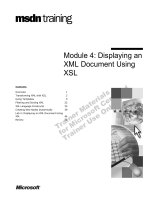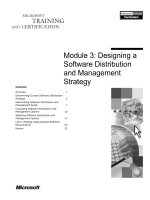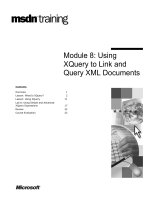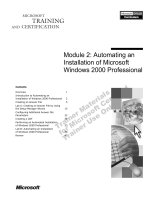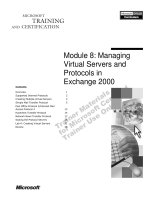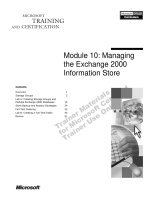Tài liệu Module 8: Designing an Exchange 2000 Management and Operations Plan pptx
Bạn đang xem bản rút gọn của tài liệu. Xem và tải ngay bản đầy đủ của tài liệu tại đây (1.33 MB, 40 trang )
Contents
Overview 1
Introduction to Designing an
Exchange 2000 Management and
Operations Plan 2
Designing a Change Plan 9
Designing an Operations Plan 16
Designing a Support Plan 23
Designing an Optimization Plan 28
Discussion: Creating a Management
and Operations Plan 34
Module 8: Designing an
Exchange 2000
Management and
Operations Plan
Information in this document is subject to change without notice. The names of companies,
products, people, characters, and/or data mentioned herein are fictitious and are in no way intended
to represent any real individual, company, product, or event, unless otherwise noted. Complying
with all applicable copyright laws is the responsibility of the user. No part of this document may
be reproduced or transmitted in any form or by any means, electronic or mechanical, for any
purpose, without the express written permission of Microsoft Corporation. If, however, your only
means of access is electronic, permission to print one copy is hereby granted.
Microsoft may have patents, patent applications, trademarks, copyrights, or other intellectual
property rights covering subject matter in this document. Except as expressly provided in any
written license agreement from Microsoft, the furnishing of this document does not give you any
license to these patents, trademarks, copyrights, or other intellectual property.
2001 Microsoft Corporation. All rights reserved.
Microsoft, Active Directory, BackOffice, FrontPage, NetMeeting, Outlook, PowerPoint,
SQL Server, Visio, Visual Studio, Win32, Windows, Windows Media, and Windows NT are either
registered trademarks or trademarks of Microsoft Corporation in the U.S.A. and/or other countries.
Other product and company names mentioned herein may be the trademarks of their respective
owners.
Module 8: Designing an Exchange 2000 Management and Operations Plan iii
Instructor Notes
This module provides students with the tools and strategies necessary for
designing a Microsoft
®
Exchange 2000 management and operations plan, which
includes a change plan, an operations plan, a support plan, and an optimization
plan.
After completing this module, students will be able to:
!"
Describe service solutions and information technology (IT) service
management functions, and explain how these relate to the four plans that
comprise a management and operations plan.
!"
Design a change plan.
!"
Design an operations plan.
!"
Design a support plan.
!"
Design an optimization plan.
Materials and Preparation
This section provides the materials and preparation tasks that you need to teach
this module.
Required Materials
To teach this module, you need the following materials:
!"
Microsoft PowerPoint
®
file 1573A_08.ppt
!"
The Service Solution Change Request Form job aid
!"
The Northwind Traders Case Study
Preparation Tasks
To prepare for this module, you should:
!"
Read all of the materials for this module.
!"
Review the Service Solution Change Request Form job aid.
!"
Review the Northwind Traders Case Study.
!"
Create the change request that is used in the instructor-led discussion.
The job aids are in the Exchange 2000 Design Tool located at
C:\MOC\1573A\LabFiles\Exchange_2000_Design_Tool, and on the student
compact disc. The case studies are in the Appendices and on the student
compact disc.
Presentation:
45 Minutes
Note
iv Module 8: Designing an Exchange 2000 Management and Operations Plan
Module Strategy
Use the following strategy to present this module:
!"
Introduction to Designing an Exchange 2000 Management and Operations
Plan
The purpose of this topic is to provide an overview of the four plans that
comprise a management and operations plan—the change plan, operations
plan, support plan, and optimization plan, which correspond to each of the
remaining topics in this module. Begin by defining service solutions and IT
service management and providing examples of each. Then, briefly discuss
each of the four plans, and also the importance of documenting all plans and
changes.
!"
Designing a Change Plan
Explain the function of a change plan, and then describe the three service
management functions that are used to implement the plan: change
management, configuration management, and release management.
!"
Designing an Operations Plan
Explain the function of an operations plan, and then describe the five
functions that should be included in an operations plan: system
administration, monitoring and measurement, security administration,
network administration, and maintenance.
!"
Designing a Support Plan
Explain the function of a support plan and then describe the three functions
that the plan includes: problem management, disaster recovery, and service
level agreement (SLA) implementation.
!"
Designing an Optimization Plan
Explain the function of an optimization plan, and then describe the three
functions that the plan includes: capacity planning, cost management, and
contingency planning.
Delivery Tip
An alternative method for
teaching this module is to
use the diamond slides as
talking points and simply
provide high-level
information on each sub-
topic, rather than going
through the module page-
by-page.
Module 8: Designing an Exchange 2000 Management and Operations Plan 1
Overview
!
Introduction to Designing an Exchange 2000
Management and Operations Plan
!
Designing a Change Plan
!
Designing an Operations Plan
!
Designing a Support Plan
!
Designing an Optimization Plan
As an Information Technology (IT) professional, you must ensure that all IT
service solutions, including those provided by Microsoft
®
Exchange 2000, are
aligned with the business needs of your company. You must take a strategic
approach to creating a sound management plan that accommodates IT service
management and its four subordinate plans: the change plan, the operations
plan, the support plan, and the optimization plan.
After completing this module, you will be able to:
!"
Describe service solutions and IT service management functions, and
explain how these relate to the four plans that make-up a management and
operations plan.
!"
Design a change plan.
!"
Design an operations plan.
!"
Design a support plan.
!"
Design an optimization plan.
Topic Objective
To provide an overview of
the module topics and
objectives.
Lead-in
In this module, you will learn
how to design an
Exchange 2000
management and
operations plan.
2 Module 8: Designing an Exchange 2000 Management and Operations Plan
#
##
#
Introduction to Designing an Exchange 2000
Management and Operations Plan
!
Providing Service Solutions and IT Service Management
Functions
!
Overview of the Management and Operations Plan
Process
!
Documenting Plans and Changes
Before designing an Exchange 2000 management and operations plan, you
must understand two important concepts: service solutions and IT service
management. Service solutions are the capabilities or business solutions that IT
provides to a company, while IT service management is the process by which
these solutions are implemented.
IT service management is cyclical in nature and includes four distinct plans that
run concurrently and that culminate in the design of a management and
operations plan. Once you have a high-level understanding of the operation and
management process, it is important to understand how to create and maintain
system documentation.
Topic Objective
To introduce the concept of
service solutions and IT
service management, and to
provide an overview of the
management and
operations plan process.
Lead-in
Because a management
and operations plan is made
up of four distinct plans, it is
important to gain a high-
level overview of the entire
process.
Module 8: Designing an Exchange 2000 Management and Operations Plan 3
Providing Service Solutions and IT Service Management Functions
SQL
SQL
Exchange 2000
Messaging Solution Data Storage Solution
Service Solutions
Service Solutions
Service Solutions
Well-defined service management functions provide consistent policies,
procedures, standards, and best practices that can be applied to any IT service
solution.
Service Solutions
Service solutions enable you to design IT services that meet your company’s
business goals. Some examples of service solutions include messaging solutions
and data storage solutions.
Messaging Solutions
As a messaging solution, Exchange 2000 extends basic messaging functionality
to provide enhanced client application and server functionality, such as:
!"
Interconnectivity with other messaging systems.
!"
Enhanced security.
!"
Multiple stores for both mailboxes and public folders.
!"
Recipient and storage policies.
!"
Access through various client applications, including:
•
A Messaging Application Programming Interface (MAPI) client, such as
Microsoft Outlook
®
.
•
A Web browser.
•
A Microsoft Office application, such as Microsoft Word.
Topic Objective
To provide some examples
of service solutions and IT
service management
functions.
Lead-in
Before designing an
Exchange 2000
management and
operations plan, you must
be aware of the service
solutions that you can
provide by using
Exchange 2000.
Delivery Tip
Mention to students that
other applications—and not
only those that provide basic
messaging functionality—
may require a management
and operations plan.
4 Module 8: Designing an Exchange 2000 Management and Operations Plan
Data Storage Solutions
As a data storage solution, Microsoft SQL Server
™
2000 combines database
functionality with data analysis to enable you to create business solutions, such
as:
!"
A technical support call-logging database that, in combination with data
analysis, tracks problems and resolutions, and also provides insight into the
enterprise’s overall technology structure and its possible vulnerabilities.
!"
Data mining that assists in uncovering hidden patterns and predicting future
trends.
!"
E-commerce solutions that can be used in conjunction with Microsoft
Commerce Server to provide Internet-based functionality, such as the ability
to store, query, and maintain the security of Web data.
IT Service Management
IT service management functions facilitate such processes as adding, removing,
or upgrading an IT service or its components. Examples of IT service
management functions include:
!"
Technical support functionality
!"
Problem management
!"
Contingency planning
!"
Configuration management
!"
Change management
!"
System administration
Module 8: Designing an Exchange 2000 Management and Operations Plan 5
Overview of the Management and Operations Plan Process
O
P
T
I
M
I
Z
I
N
G
C
H
A
N
G
I
N
G
O
P
E
R
A
T
I
N
G
S
U
P
P
O
R
T
I
N
G
IT
IT
Service
Service
Mgt.
Mgt.
Each of the remaining four sections of this module explores one of the four
plans that make up a management and operations plan: the change plan, the
operations plan, the support plan, and the optimization plan.
Designing a Change Plan
Because both users and day-to-day business operations are affected whenever a
new service solution is deployed, designing a change plan to manage change is
crucial to the project’s success. Although designing a change plan is the first
step in creating an Exchange 2000 management and operations plan, it should
be implemented throughout the entire life cycle of the project. An effective
change plan must address the following service management functions:
!"
Change management
!"
Configuration management
!"
Release management
Designing an Operations Plan
An operations plan outlines the standards, processes, procedures, roles, and
responsibilities that are necessary to maintain the required levels of service
within a company. This plan includes the following functions:
!"
System administration
!"
Monitoring and measurement
!"
Security administration
!"
Network administration
!"
Maintenance
Topic Objective
To provide a high-level
overview of the plans that
make up a management
and operations plan.
Lead-in
Creating a management and
operations plan involves
developing four plans:
changing, operating,
supporting, and optimizing.
6 Module 8: Designing an Exchange 2000 Management and Operations Plan
Designing a Support Plan
A support plan outlines the standards, processes, and procedures needed to
track and resolve each problem as it arises. This plan includes the following
functions:
!"
Problem management
!"
Disaster recovery
!"
Service Level Agreement (SLA) Implementation
Designing an Optimization Plan
An optimization plan outlines the methods for achieving better performance
from the current system. This plan includes the following functions:
!"
Capacity planning
!"
Cost management
!"
Contingency planning
Module 8: Designing an Exchange 2000 Management and Operations Plan 7
Documenting Plans and Changes
System mission statement
Infrastructure diagrams
Logical diagrams
Software-related information
Procedures
Maintenance information
Contact and Web site information
Include the following information in
your documentation:
Include the following information in
Include the following information in
your documentation:
your documentation:
Creating and maintaining documentation is an extremely important aspect of
system support. When changes are made to your system, or when errors occur
within your system, documentation is the only reliable source of information
that you have regarding the configuration of your system. The following table
lists the types of information that you should include in your documentation.
Type of information Topics included
System mission statement Project scope
Design goals
Project milestones, phases, and signoff
information
Infrastructure diagrams Physical network
Network routing
Domain structure
Server location
Other system connectivity
Logical diagrams Network administration
Network server roles
Operating system administration
Messaging system administration
Message routing
Other system connectivity
Other system administration
Topic Objective
To outline the type of
information that you should
include in your
documentation.
Lead-in
Maintaining proper
documentation is crucial to
the ongoing success of any
deployment.
8 Module 8: Designing an Exchange 2000 Management and Operations Plan
(
continued
)
Type of information Topics included
Software-related information
Current software installed
Current version information
File location tables
Software update diary
Error logs and reports
Procedures Backing up systems
Restoring systems
Disaster recovery
Updating and upgrading software
Adding new hardware
Adding new software
Error escalation
Maintenance information Network
Application
Logging
Scheduling backups
Running repair utilities
Contact and Web site information Supplier information
Internal support staff
Project consultants
List of useful Web sites
Delivery Tip
Mention that when
documenting software-
related information, it is
important to include
documentation on virus-
scanning software.
Module 8: Designing an Exchange 2000 Management and Operations Plan 9
#
##
#
Designing a Change Plan
C
H
A
N
G
I
N
G
S
U
P
P
O
R
T
I
N
G
O
P
E
R
A
T
I
N
G
O
P
T
I
M
I
Z
I
N
G
IT
IT
Service
Service
Mgt
Mgt
.
.
Change Management
Change Management
Configuration Management
Configuration Management
Release Management
Release Management
A well-designed change plan will help you to minimize any adverse effects that
the implementation of the new system might have on users and on day-to-day
business operations. To ensure that the change occurs in a controlled fashion
and that users have uninterrupted access to system resources, the change plan
must document all of the processes and procedures for implementing the IT
service change.
The following three service management functions are used to implement a
change plan:
!"
Change management
!"
Configuration management
!"
Release management
For more information about change management, see Process Model for
Operations under Additional Readings on the Student Materials compact disc.
Topic Objective
To define the purpose of a
change plan, and to
describe the three service
management functions that
support it.
Lead-in
A change plan includes the
procedures required to
identify, review, approve,
and incorporate changes
into a managed IT
environment.
Note
10 Module 8: Designing an Exchange 2000 Management and Operations Plan
Change Management
Analyze any risks imposed by the change
Analyze any risks imposed by the change
Ensure user awareness of the change
Ensure user awareness of the change
C
H
A
N
G
I
N
G
S
U
P
P
O
R
T
I
N
G
O
P
E
R
A
T
I
N
G
O
P
T
I
M
I
Z
I
N
G
IT
IT
Service
Service
Mgt
Mgt
.
.
Identify the change
Identify the change
Analyze the effect of the change on IT services
Analyze the effect of the change on IT services
Change management ensures a smooth transition from the system’s current
state to the new state while also ensuring that everyone affected by the change
is aware of it and understands the effect that it will have on the company.
Change Management Functions
The goal of change management is to:
!"
Identify the change that needs to be made.
!"
Analyze the effects of the change on other IT services.
!"
Analyze any risks imposed by the change.
!"
Ensure that everyone affected by the change is aware of its effects.
With careful analysis and planning, you will have a clear idea of the specific
areas that will be affected by the change, how these areas will be affected, the
time required to implement the change, and the personnel responsible for
implementing it.
Change Management Resources
The resources affected by any one change may include hardware, software,
systems communications, and documentation.
Hardware
Changes made to system hardware may result in network downtime. When you
are planning to make changes to the network’s hardware infrastructure, you
must project how those changes will affect users, and how much time it will
take to make the changes.
Topic Objective
To describe the functions of
change management.
Lead-in
The goal of the change
management process is to
ensure that everyone
affected by the change is
aware of it and understands
its effects.
Delivery Tip
Mention that change
management entails
understanding the change
process and its possible
effect well enough that the
decision can be made to
back out of the change and
return the system to its
original state if necessary.
Module 8: Designing an Exchange 2000 Management and Operations Plan 11
Software
How users and services are affected by a software change depends on the type
of change that is made. For example, completely reinstalling an application
affects users and services differently than simply updating a service pack.
However, because all software changes result in some loss of service, you must
carefully plan the change in order to minimize its effects on users and on
business operations.
Systems Communications
Any change that affects the links between physical locations, servers, and
connections to other systems can disrupt both users and day-to-day business
operations. Therefore, it is important to watch for any changes in the
configuration of how systems communicate with one another.
Documentation
All changes made to the system must be carefully documented. Accurate and
timely documentation is vital to the ongoing maintenance and support of the
system infrastructure.
Change Management Characteristics
Key elements of change management include:
!"
Change controls. Changes should be managed along a range of control
points from automated approval to full project level reviews, and should be
proportionate to complexity, cost, risk, and impact.
!"
CRFs. The change request forms (CRFs) should include descriptions of the
change requested, the components affected, the business need, cost
estimates, risk assessment, resource requirements, rollback procedures, and
approval status.
For more information about change requests, see Service Solution
Change Request Form under Additional Readings on the Student Materials
compact disc.
!"
CAB. The change advisory board (CAB) is a group established to evaluate
change requests in terms of business need, priority, cost/benefit, and
potential effects on other systems or processes. The CAB typically makes
recommendations for either the implementation, the further analysis, the
deferment, or the cancellation of the requested change.
Note
12 Module 8: Designing an Exchange 2000 Management and Operations Plan
Configuration Management
C
H
A
N
G
I
N
G
S
U
P
P
O
R
T
I
N
G
O
P
E
R
A
T
I
N
G
O
P
T
I
M
I
Z
I
N
G
IT
IT
Service
Service
Mgt
Mgt
.
.
Configuration management planning
Configuration management planning
Configuration identification
Configuration identification
Configuration control
Configuration control
Configuration status accounting
Configuration status accounting
Configuration verification and audit
Configuration verification and audit
Configuration management is the maintenance of the structure and integrity of a
company’s system infrastructure by means of identifying, recording, tracking,
and reporting the company’s IT service components and organizational assets.
These components and assets are typically the same as those listed in change
management, and include hardware, software, system communications, and
documentation. Information regarding IT service components and assets must
be stored in a central data repository. The best practice is to store this
information in a database that generates automatic updates.
Configuration management is not the same as asset management. Asset
management is an accounting process that is typically used to track depreciation
and cost.
Topic Objective
To describe the function of
configuration management.
Lead-in
The goal of the configuration
management process is to
identify, record, track, and
report IT service
components and
organizational assets.
Note
Module 8: Designing an Exchange 2000 Management and Operations Plan 13
Configuration Management Functions
The basic functions of configuration management include:
!"
Configuration management planning. This involves identifying the scope
objectives, policies, procedures, organizational, and technical contexts for
configuration management.
!"
Configuration identification. This involves identifying the configuration for
all of the infrastructure’s components and organizational assets, their
owners, their interrelationships, and the necessary configuration
documentation.
!"
Configuration control. This involves ensuring that only authorized and
identifiable components and organizational assets are accepted and
recorded. In addition, configuration control involves ensuring that no
components or organizational assets are added, replaced, or removed
without appropriate controlling documentation, such as an approved change
request or updated specification.
!"
Configuration status accounting. This involves reporting all current and
historical data on every component and organizational asset in order to
enable changes to components or organizational assets and to make their
records traceable.
!"
Configuration verification and audit. This involves verifying the physical
existence of each component or organizational asset, and ensuring that each
is correctly recorded in the configuration management system.
Managing Configuration Changes
Before making any configuration changes to your Exchange 2000 organization,
you need to understand how Exchange 2000 is configured to work with:
!"
Other messaging systems.
!"
Routing groups.
!"
Administration groups.
!"
System and recipient policies.
14 Module 8: Designing an Exchange 2000 Management and Operations Plan
Release Management
Managing Release Expectations
Managing Release Expectations
Set accurate expectations with staff and management
Set accurate expectations with staff and management
Discuss time frame, performance, and risks
Discuss time frame, performance, and risks
Creating a Roll-Out Plan
Creating a Roll-Out Plan
Identify systems and users affected by roll-out
Identify systems and users affected by roll-out
Identify the time frame for roll-out
Identify the time frame for roll-out
Identify procedure for implementing roll-out
Identify procedure for implementing roll-out
Creating a Roll-Back Plan
Creating a Roll-Back Plan
Identify the procedures for returning the system to its original
state in the event of a system-threatening error
Identify the procedures for returning the system to its original
state in the event of a system-threatening error
Release management is the process of introducing change, such as the
introduction of a new or a modified service solution, into a managed IT
environment, typically either a production environment or a pre-production
environment. Release management provides a controlled process for
distributing and tracking releases, such as an Exchange 2000 messaging service
solution.
Because any new release involves an IT service change, release management is
closely related to both change management and configuration management.
Release management typically involves managing release expectations, creating
a rollout plan, and creating a rollback plan.
Managing Release Expectations
Before releasing any software or hardware into a production environment, it is
essential that you:
!"
Set accurate expectations with your company’s staff and management
regarding the upcoming implementation.
!"
Discuss factors such as time frame, performance, cost, and risks.
Topic Objective
To explain that release
management usually
involves managing release
expectations and creating a
rollout plan and a rollback
plan.
Lead-in
The goal of the release
management process is to
introduce change into a
production or pre-production
environment.
Module 8: Designing an Exchange 2000 Management and Operations Plan 15
Creating a Rollout Plan
An effective rollout plan takes both the company and its users into
consideration by identifying:
!"
The systems and users affected by the rollout.
!"
The time frame for the rollout.
!"
The procedure for implementing the rollout.
For example, a rollout plan for a hardware update that involves adding an
additional network card to a server running Exchange 2000 should clearly
identify:
!"
Which server is being upgraded and how the upgrade will affect users
!"
Which technicians are performing the upgrade
!"
The estimated time frame for the upgrade
!"
Any additional software that may be required
!"
The procedures for updating the existing documentation
Creating a Rollback Plan
A rollback plan lists the procedures that are required to return a system or an
application to its original state in the event of a system-threatening error. If such
an error occurs during any phase of the rollout, it is crucial to be able to return
to the last phase in which the system was running correctly.
16 Module 8: Designing an Exchange 2000 Management and Operations Plan
#
##
#
Designing an Operations Plan
Configuration management planning
Configuration management planning
Configuration identification
Configuration identification
Configuration control
Configuration control
Configuration status accounting
Configuration status accounting
Configuration verification and audit
Configuration verification and audit
O
P
E
R
A
T
I
N
G
C
H
A
N
G
I
N
G
S
U
P
P
O
R
T
I
N
G
O
P
T
I
M
I
Z
I
N
G
IT
IT
Service
Service
Mgt
Mgt
.
.
An operations plan includes the standards and procedures that are required to
ensure the effective day-to-day operation of a newly installed service solution,
such as Exchange 2000. This plan includes operations guides that contain the
step-by-step procedures that are needed to accomplish specific tasks, as well as
the processes for using past experiences to review and update current
procedures. Procedures should be tested regularly for accuracy, and should be
updated manually or automatically whenever any change is made.
The following functions should be included in any Exchange 2000 operations
plan:
!"
System administration
!"
Monitoring and measurement
!"
Security administration
!"
Network administration
!"
Maintenance
For more information about operations management, see Process Model
for Operations under Additional Readings on the Student Materials compact
disc.
Topic Objective
To explain the purpose of an
operations plan, and to
describe the functions that
support it.
Lead-in
The goal of an operations
plan is the automated,
highly predictable
implementation of day-to-
day tasks.
Note
Module 8: Designing an Exchange 2000 Management and Operations Plan 17
System Administration
System Installation
System Installation
Software Installation
Software Installation
Configuration
Configuration
Connectivity
Connectivity
Account Management
Account Management
O
P
E
R
A
T
I
N
G
C
H
A
N
G
I
N
G
S
U
P
P
O
R
T
I
N
G
O
P
T
I
M
I
Z
I
N
G
IT
IT
Service
Service
Mgt
Mgt
.
.
In an Exchange 2000 environment, an effective operations plan for system
administration includes the procedures that are used to ensure that the
messaging system is consistently and automatically maintained. Because
Exchange 2000 relies on the Microsoft Active Directory
™
service to provide its
directory services, these procedures should also include information about the
servers running Windows 2000, because these servers maintain the directory
information that Exchange 2000 uses.
At the very least, the operations plan should provide procedures for the
following system administration tasks:
!"
System installation. These procedures should include hardware and software
standards for the CPU, memory requirements, and hard disk requirements
for every server type that is used in the organization. Types of servers to
consider include:
•
Global catalog servers
•
Domain controllers
•
Mailbox servers
•
Public folder servers
•
Connector servers
!"
Software installation. These procedures should include the standards for
installing the operating system, the specific configurations that the operating
system must support so that the server functions properly, and the standards
for installing applications on the server.
Topic Objective
To present the system
administration procedures
that should be included in
an operations plan.
Lead-in
A complete operations plan
for system administration
includes procedures for
system and software
installation, for
configuration, for
connectivity, and for account
management.
18 Module 8: Designing an Exchange 2000 Management and Operations Plan
!"
Configuration. These procedures should include standards for delegating
administrative control, configuring virtual servers, and applying policies.
!"
Connectivity. These procedures should include standards for creating
connections to other systems, including existing Exchange 2000 systems, as
well as to other e-mail systems or applications.
!"
Account management. These procedures should include standards for
creating accounts, including users, groups, and contacts, as well as naming
conventions and any additional account details, such as phone numbers, that
will be stored in Active Directory.
Module 8: Designing an Exchange 2000 Management and Operations Plan 19
Monitoring and Measurement
System Monitoring
System Monitoring
System Measurement
System Measurement
O
P
E
R
A
T
I
N
G
C
H
A
N
G
I
N
G
S
U
P
P
O
R
T
I
N
G
O
P
T
I
M
I
Z
I
N
G
IT
IT
Service
Service
Mgt
Mgt
.
.
An effective operations plan for monitoring and measurement defines the tools
and tasks that are necessary to ensure that Exchange 2000 runs at optimal
efficiency and with minimal downtime. This plan also ensures that you gather
the appropriate information to manage the Exchange 2000 system proactively
and perform trend analysis and capacity planning.
At the very least, the operations plan should provide procedures for the
following monitoring and measurement tasks:
!"
System monitoring. These procedures should include information on server
resources that should be monitored, including memory, processor
utilization, hard disk space and performance, and network performance.
Applications, such as Exchange 2000, should be monitored based on the
role the server running Exchange 2000 is performing. Exchange 2000
systems should be monitored for store performance; message delivery and
message queues, and performance in connecting to other e-mail systems and
applications. Finally, procedures should exist for reviewing system and
applications logs.
Each of these procedures should specify the frequency of monitoring tasks,
the baseline or expected data to be captured, and appropriate escalation
procedures for managing problems as they arise.
!"
System measurement. These procedures work in conjunction with system
monitoring procedures, and should include standards for the types of
information measured, the measurement sampling rate, the equations to be
used when analyzing data, the format the data will be stored in, and the
formats used for reporting.
Topic Objective
To present the monitoring
and measurement
procedures that should be
included in an operations
plan.
Lead-in
An effective operations plan
includes procedures for
system monitoring and
system measurement.
20 Module 8: Designing an Exchange 2000 Management and Operations Plan
Security Administration
System Security
System Security
Security Monitoring and Auditing
Security Monitoring and Auditing
O
P
E
R
A
T
I
N
G
C
H
A
N
G
I
N
G
S
U
P
P
O
R
T
I
N
G
O
P
T
I
M
I
Z
I
N
G
IT
IT
Service
Service
Mgt
Mgt
.
.
An operations plan for security administration should define the tools and tasks
necessary to ensure that Exchange 2000 is secure from both internal and
external security threats. The goal of security procedures is to safeguard
physical and intellectual property from unauthorized access, viruses, or theft of
data.
At the very least, the operations plan should provide procedures for:
!"
System security. These procedures should define standards for protecting
servers from physical and intentionally engineered attacks, such as e-mail
viruses. Software standards and update procedures should be included, and
should apply both to the operating system and to any specific applications
that are running on the system. Finally, procedures should define standards
for remote access.
!"
Security monitoring and auditing. These procedures should define standards
for both manually and automatically monitoring the system for possible
security breaches. If possible, the procedures should also define standards
and policies for monitoring both data retention and communication. Finally,
procedures for managing escalation should be defined.
Topic Objective
To discuss the system
security procedures that
should be included in an
operations plan.
Lead-in
An effective operations plan
should include procedures
for ensuring system
security.
Module 8: Designing an Exchange 2000 Management and Operations Plan 21
Network Administration
Hardware and Software Management
Hardware and Software Management
Firewall Management
Firewall Management
O
P
E
R
A
T
I
N
G
C
H
A
N
G
I
N
G
S
U
P
P
O
R
T
I
N
G
O
P
T
I
M
I
Z
I
N
G
IT
IT
Service
Service
Mgt
Mgt
.
.
Network administration has a direct effect on the performance of
Exchange 2000. Operations procedures should define the tools and tasks that
are required to ensure that the network is appropriately maintained to support
Exchange 2000.
At the very least, the operations guide should provide procedures for the
following tasks:
!"
Hardware and software management. These procedures should include
standards for network components, including network interface cards, hubs,
switches, and routers. Procedures for configuring any required software
components, including supported protocols, should also be included.
!"
Firewall management. Based on the applications that are currently in use,
these procedures should include configuration information, including
protocol and port configurations. Procedures for configuring systems that
are positioned in the perimeter network, such as a front-end server, should
also be included.
Topic Objective
To discuss the network
administration procedures
that should be included in
an operations plan.
Lead-in
An effective operations plan
for network administration
includes procedures for
hardware and software
management, as well as
firewall management.
